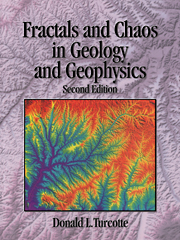Book contents
- Frontmatter
- Contents
- Preface
- Preface to the second edition
- 1 Scale invariance
- 2 Definition of a fractal set
- 3 Fragmentation
- 4 Seismicity and tectonics
- 5 Ore grade and tonnage
- 6 Fractal clustering
- 7 Self-affine fractals
- 8 Geomorphology
- 9 Dynamical systems
- 10 Logistic map
- 11 Slider-block models
- 12 Lorenz equations
- 13 Is mantle convection chaotic?
- 14 Rikitake dynamo
- 15 Renormalization group method
- 16 Self-organized criticality
- 17 Where do we stand?
- References
- Appendix A Glossary of terms
- Appendix B Units and symbols
- Answers to selected problems
- Index
17 - Where do we stand?
Published online by Cambridge University Press: 05 June 2012
- Frontmatter
- Contents
- Preface
- Preface to the second edition
- 1 Scale invariance
- 2 Definition of a fractal set
- 3 Fragmentation
- 4 Seismicity and tectonics
- 5 Ore grade and tonnage
- 6 Fractal clustering
- 7 Self-affine fractals
- 8 Geomorphology
- 9 Dynamical systems
- 10 Logistic map
- 11 Slider-block models
- 12 Lorenz equations
- 13 Is mantle convection chaotic?
- 14 Rikitake dynamo
- 15 Renormalization group method
- 16 Self-organized criticality
- 17 Where do we stand?
- References
- Appendix A Glossary of terms
- Appendix B Units and symbols
- Answers to selected problems
- Index
Summary
The concepts of fractals and chaos were introduced in 1967 (Mandelbrot, 1967) and in 1963 (Lorenz, 1963), respectively. Unlike many advances in science, the attribution is in both cases quite clear. In both cases it took more than 10 years before either concept received wide attention. Today, most scientists take these concepts for granted, although their utility may be questioned. The concept of self-organized criticality was introduced in 1988 (Bak et al., 1988). Again the attribution is not open to question, but the definition of the concept remains somewhat unclear, particularly in. regard to classical problems in criticality.
There is no question that fractals are a useful empirical tool. They provide a rational means for the extrapolation and interpolation of observations. The normal distribution and the power-law (fractal) distribution have very wide applicability. Just as the central limit theorem provides a broad base for the application of the normal distribution, scale invariance provides a basis for the application of the power-law distribution. Some statisticians argue that fractals are a trivial extension of the Pareto distribution. But in its general form, the Pareto distribution is not scale invariant and historically it has been applied empirically without justification.
A strong case can certainly be made for the wide applicability of power-law (fractal) distributions, but does this applicability have a more fundamental basis? Fractality appears to be fundamentally related to chaos and selforganized criticality.
The chaotic behavior of deterministic nonlinear maps and sets of differential equations has been demonstrated beyond question.
- Type
- Chapter
- Information
- Fractals and Chaos in Geology and Geophysics , pp. 341 - 342Publisher: Cambridge University PressPrint publication year: 1997



